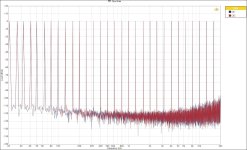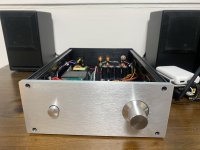If you are using Firefox, I have found this web page translator to work very well:
https://addons.mozilla.org/en-US/firefox/addon/traduzir-paginas-web/
It cannot help if too many slang expressions are used...
https://addons.mozilla.org/en-US/firefox/addon/traduzir-paginas-web/
It cannot help if too many slang expressions are used...
@muducu He means:You don't want dirty obviously, but I think the main difference in sound between Hypex and some mentioned here is caused by the Hypex ones not being regulated, or regulated very loosely. The Hypex's are allowed to drop voltage under load, the Meanwells and Connex's do not. My 2 cents.
You do not want (dirty = power supplies with a lot of noise) obviously but I think the main difference in sound between Hypex and some mentioned here is caused by the Hypex power supplies not being regulated, or regulated very loosely [power supplies used by Hypex that have a voltage that is allowed to drop when current is taken from the supply. (A "regulated power supply" means the output voltage does not change when current is taken from the supply)].
The Hypex's are allowed to drop voltage under load, the Meanwells and Connex's do not. --> Hypex power supplies are non regulated. The Meanwell and ConnexElectronic power supplies are regulated.
My 2 cents. --> This is my opinion, which is worth very little, e.g. only 2 cents. This is a common English slang expression.
Thanks CharlieLaub 😉
It's much clearer with your explanation.
So HYPEX would use 'worse' power supplies yet they get great results on ASR.
In France we also use the expression: "ça ne vaut pas deux balles !" 🙂
It's much clearer with your explanation.
So HYPEX would use 'worse' power supplies yet they get great results on ASR.
In France we also use the expression: "ça ne vaut pas deux balles !" 🙂
The load regulation of a power supply (how much the voltage drops when the supply delivers current) is just one characteristic of power supply performance. So you cannot say one is better than the other without looking at all the variables involved.
You are absolutely right but I think that if the voltage drops since it is not regulated it must impact the dynamics as well as the transients of the amplifier...
P = UIcos ϕ
Then 'I' will increase strongly so the power supply will heat up more necessarily, which is not at all the desired goal, quite the contrary !
P = UIcos ϕ
Then 'I' will increase strongly so the power supply will heat up more necessarily, which is not at all the desired goal, quite the contrary !
The use of a regulated power supply reminds me a bit of class A amplifiers with their quiescent current whereas in their case it is voltage 🙄
A reliable 'source' has just confirmed the following things for me ->
"...What's important is that it should not produce an audible noise at idle. Some SMPS produce audible noise in power saving mode.
Even if the power supply has bad harmonics on the fft spectrum, it might not be audible at all..."
🙂
So the MORNSUN power supply looks good ->

But 3eAudio did not confirm if the power saving relay problem had been fixed (They did not specify the model that was measured either)...
Regarding the MEANWELL UPH-350R-48 power supply, we have no information 🙁
"...What's important is that it should not produce an audible noise at idle. Some SMPS produce audible noise in power saving mode.
Even if the power supply has bad harmonics on the fft spectrum, it might not be audible at all..."
🙂
So the MORNSUN power supply looks good ->
But 3eAudio did not confirm if the power saving relay problem had been fixed (They did not specify the model that was measured either)...
Regarding the MEANWELL UPH-350R-48 power supply, we have no information 🙁
Last edited:
The amplifier is able to suppress or almost completely eliminate (reject) non-DC signals or harmonics, etc. that come to it via the power supply. This ability is called the "Power Supply Rejection Ratio" (abbreviation=PSRR) in English. The PSRR is not the same for all frequencies. So even if the power supply has some of these "noise" components they are probably not coming out of the amplifier, or do that but at a much lower level that is not audible and possibly very difficult or impossible to measure because they are so small. It depends on a couple of different factors but that is too complicated to explain here.
I've been looking at one of these https://micro-audio.com/store/product/smps1ks-pfcr2/ SMPS for a multichannel build with these amp modules. They seem well regarded and have a 12v trigger input which I can use from the Topping DM7 I will be using. They are unregulated however, and I'm not sure what the consequences of this will be.
@muducuA reliable 'source' has just confirmed the following things for me ->
"...What's important is that it should not produce an audible noise at idle. Some SMPS produce audible noise in power saving mode.
Even if the power supply has bad harmonics on the fft spectrum, it might not be audible at all..."
🙂
So the MORNSUN power supply looks good ->
View attachment 1160598
But 3eAudio did not confirm if the power saving relay problem had been fixed (They did not specify the model that was measured either)...
Regarding the MEANWELL UPH-350R-48 power supply, we have no information 🙁
see this one, i am not understand what you mean power saving relay problem.
Attachments
Hi 'people' from 3eaudio 🙂
Have you ever heard of power supply issues (MORNSUN SMPS) with the SABAJ A20a amplifier when it switches to energy-saving mode ?
I suggest you look here ->
https://www.audiosciencereview.com/...0-fully-balanced-pictures-inside.23311/page-7
Thank you for changing the values and scales on your curve: it's much better this way and it allows you to compare what is comparable 👍
However, you do not indicate which device it is also this curve does not mean anything as it stands...
It's a shame because the curve is very good 👈
As a reminder, users generally use speakers either in 4 Ohms or in 8 Ohms: there should be two curves so that it is more representative for everyone.
Don't take my remarks the wrong way, I hope, it's just so that you are more precise in your presentation and that at the same time you will be the only ones to propose this type of measure in complete transparency, which will no doubt have an impact on your sales positively 😉
This is a very positive point for you, because MEANWELL does not (maybe they have a reason ?)
Regards.
Have you ever heard of power supply issues (MORNSUN SMPS) with the SABAJ A20a amplifier when it switches to energy-saving mode ?
I suggest you look here ->
https://www.audiosciencereview.com/...0-fully-balanced-pictures-inside.23311/page-7
Thank you for changing the values and scales on your curve: it's much better this way and it allows you to compare what is comparable 👍
However, you do not indicate which device it is also this curve does not mean anything as it stands...
It's a shame because the curve is very good 👈
As a reminder, users generally use speakers either in 4 Ohms or in 8 Ohms: there should be two curves so that it is more representative for everyone.
Don't take my remarks the wrong way, I hope, it's just so that you are more precise in your presentation and that at the same time you will be the only ones to propose this type of measure in complete transparency, which will no doubt have an impact on your sales positively 😉
This is a very positive point for you, because MEANWELL does not (maybe they have a reason ?)
Regards.
Last edited:
Attachments
Last edited:
People hi 🙂
I agree with 3eAudio: I would even add that you can twist ALL the cables 😉
For your DC voltage cable between your power supply and your amplifier PCB, you can also take inspiration from what I did with my amp ->





As you will notice: the cables are covered with heat-shrink sheath for finishing and to avoid possible false contacts.
Just for information, my chassis was covered inside with anti-EMI tape (FARADAY cage style) then covered with another tape this time electrical insulation for the same reason as before.
Who can do more, can do less 😎
PS:
As for the diameter of your speaker output wires, you must think about the diameter of your woofer coil wires:
I doubt they'll even be 1 millimeter in diameter, which might give you an idea of the advantage of using large diameter wire unless you use your amplifier more than 100 meters from your speakers to avoid linear losses... 🙄
Also, the use of 'silver wire' (or other 'precious' or 'magic' material) will also have a significant influence on your wallet but certainly not on the quality of reproduction of your hi-fi system.😒
I say that but I said nothing...
Finally, we can do even better, other members surely have good ideas to offer you 👍
See you soon
I agree with 3eAudio: I would even add that you can twist ALL the cables 😉
For your DC voltage cable between your power supply and your amplifier PCB, you can also take inspiration from what I did with my amp ->
As you will notice: the cables are covered with heat-shrink sheath for finishing and to avoid possible false contacts.
Just for information, my chassis was covered inside with anti-EMI tape (FARADAY cage style) then covered with another tape this time electrical insulation for the same reason as before.
Who can do more, can do less 😎
PS:
As for the diameter of your speaker output wires, you must think about the diameter of your woofer coil wires:
I doubt they'll even be 1 millimeter in diameter, which might give you an idea of the advantage of using large diameter wire unless you use your amplifier more than 100 meters from your speakers to avoid linear losses... 🙄
Also, the use of 'silver wire' (or other 'precious' or 'magic' material) will also have a significant influence on your wallet but certainly not on the quality of reproduction of your hi-fi system.😒
I say that but I said nothing...
Finally, we can do even better, other members surely have good ideas to offer you 👍
See you soon

Last edited:
- Home
- Vendor's Bazaar
- TPA3255, TPA3251 with Post Filter Feedback(PFFB)


